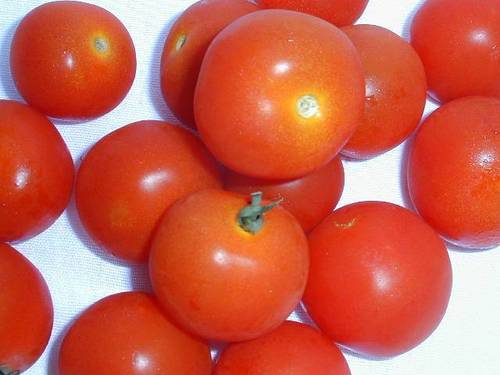Vegetable Love in Texas
By Carol Coffee Reposa
Farmers say
There are two things
Money can’t buy:
Love and homegrown tomatoes.
I pick them carefully.
They glow in my hands, shimmer
Beneath their patina of warm dust
Like talismen.
Perhaps they are.
Summer here is a crucible
That melts us down
Each day,
The sky a sheet of metal
Baking cars, houses, streets.
Out in the country
Water-starved maize
Shrivels into artifacts.
A desiccated cache
Of shredded life.
Farmers study archeology
In limp straw hats.
But still I have
This feeble harvest,
Serendipity in red:
Red like a favorite dress,
Warm like a dance,
Lush like a kiss long desired,
Firm like a vow, the hope of rain.
Image courtesy of Jacci Howard Bear https://desktoppub.about.com/
Is it a fruit or a vegetable?

A vegetable is an edible plant or part of a plants other than a sweetfruit or seed. The word is not scientific, however, but instead is largely based on culinary and cultural tradition. Thus the application of the word is somewhat arbitrary and subjective. For example, some people consider mushrooms to be vegetableswhile others consider them a separate food category.
Some vegetables can be consumed raw, and some may (or must) be cooked in various ways, most often in non-sweet (savory or salty) dishes.However, some vegetables are often used in desserts and other sweet dishes, such as pumpkin pies and carrot cakes
A Venn diagram shows the overlaps between "fruits" and "vegetables" in the informal (culinary) sense, and "fruits" in the botanical sense.

In everyday (non-technical) language, the words "fruit" and
"vegetable" are mutually exclusive: plant products that are called
fruits are hardly ever classified as vegetables, and vice-versa.
However, for scientists the word "fruit" also has a precise botanical meaning, which is considerably different from its common meaning. While peaches, plums, and oranges are "fruits" in both senses, many items commonly called "vegetables" — such as eggplants, bell peppers, and tomatoes — are technically fruits; and so are also most cereals, and some spices like pepper and chili. On the other hand, many items commonly called "fruits" — including figs, pineapples, and strawberries — are not fruits in the strict botanical sense.
The question of whether the tomato is a fruit or a vegetable found its way into the United States Supreme Court in 1893. The court ruled unanimously in Nix v. Hedden that a tomato is correctly identified as, and thus taxed as, a vegetable, for the
purposes of the 1883 Tariff Act on imported produce. The court did
acknowledge however that, botanically speaking, a tomato is a fruit.Languages other than English often have categories that can be identified with the common English
meanings of "fruit" and "vegetable", however, their precise meaning may
depend on local culinary traditions as well. For example, in Brazil the avocado is traditionally consumed with sugar as a dessert or in milk shakes,
and hence regarded as a fruit; whereas in other countries (including Mexico and the United States) it is used in salads and dips, and hence considered a vegetable.
https://en.wikipedia.org/wiki/Vegetable



